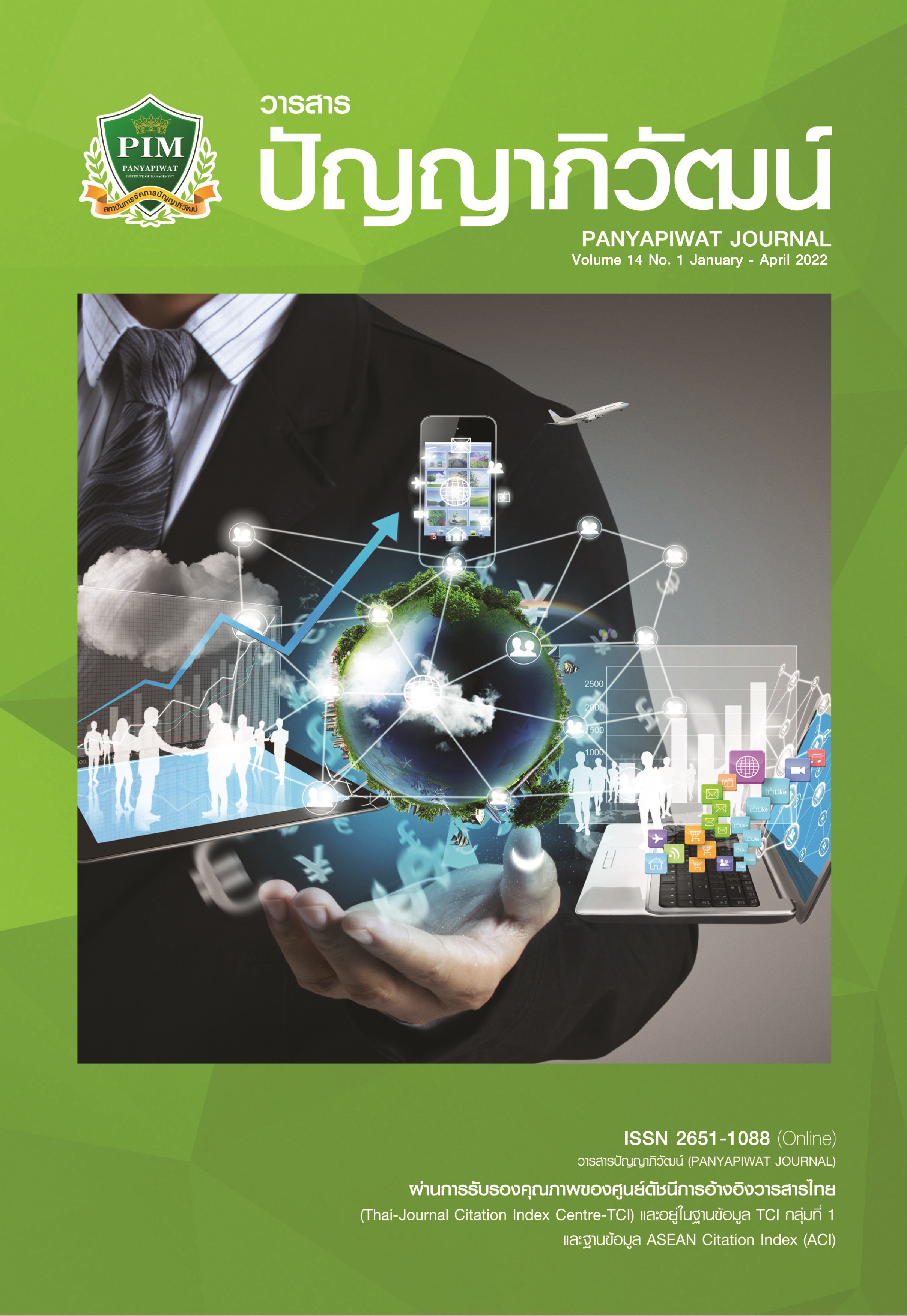ความสัมพันธ์เชิงสาเหตุในการสร้างสรรค์นวัตกรรมของผู้จัดการร้านสะดวกซื้อในประเทศไทย
Main Article Content
บทคัดย่อ
การวิจัยครั้งนี้มีวัตถุประสงค์เพื่อ 1) ศึกษาระดับความคิดเห็นต่อภาวะผู้นำการเปลี่ยนแปลงวัฒนธรรม องค์การ การแบ่งปันความรู้ ความสามารถในการดูดซับความรู้และพฤติกรรมการสร้างสรรค์นวัตกรรมของผู้จัดการร้านสะดวกซื้อในประเทศไทย 2) ศึกษาความสัมพันธ์เชิงสาเหตุด้านภาวะผู้นำการเปลี่ยนแปลง วัฒนธรรมองค์การ การแบ่งปันความรู้ ความสามารถในการดูดซับความรู้มีอิทธิพลต่อพฤติกรรมการสร้างสรรค์นวัตกรรมของผู้จัดการ ร้านสะดวกซื้อในประเทศไทย และ 3) ศึกษารูปแบบที่สนับสนุนพฤติกรรมการสร้างสรรค์นวัตกรรมของผู้จัดการร้านสะดวกซื้อในประเทศไทย ซึ่งใช้แบบสอบถามเป็นเครื่องมือในการเก็บรวบรวมข้อมูลกับกลุ่มตัวอย่าง จำนวน 500 คน วิเคราะห์ข้อมูลโดยใช้เทคนิคการวิเคราะห์แบบจำลองสมการโครงสร้างผลการวิจัยพบว่า 1) ความคิดเห็นด้านพฤติกรรมการสร้างสรรค์นวัตกรรมมีความคิดเห็นอยู่ในระดับมากที่สุด ด้านภาวะผู้นำการเปลี่ยนแปลง ด้านวัฒนธรรมองค์การ ด้านการแบ่งปันความรู้ ด้านความสามารถในการดูดซับความรู้ความคิดเห็นอยู่ในระดับมาก 2) ความสัมพันธ์เชิงสาเหตุในการสร้างสรรค์นวัตกรรมของผู้จัดการร้านสะดวกซื้อในประเทศไทยมีความกลมกลืนกับข้อมูลเชิงประจักษ์โดยมีค่า x2 = 75.307, df = 61, x2/df = 1.235, p-Value = 0.103, SRMR = 0.005, RMSEA = 0.022, GFI = 0.985, CFI = 0.999, NF I = 0.994 3) รูปแบบความสัมพันธ์เชิงสาเหตุในการสร้างสรรค์นวัตกรรมของผู้จัดการร้านสะดวกซื้อในประเทศไทย เกิดจากความสามารถในการดูดซับความรู้ และภาวะผู้นำการเปลี่ยนแปลง เมื่อพิจารณาอิทธิพลทางอ้อมของตัวแปรที่มีต่อพฤติกรรมการสร้างสรรค์นวัตกรรมของผู้จัดการร้านสะดวกซื้อในประเทศไทยพบว่า ตัวแปร การแบ่งปันความรู้มีอิทธิพลทางอ้อมโดยผ่านตัวแปรความสามารถในการดูดซับความรู้ รองลงมาคือ ตัวแปรภาวะผู้นำการเปลี่ยนแปลงมีอิทธิพลทางอ้อมโดยผ่านตัวแปรวัฒนธรรมองค์การ การแบ่งปันความรู้ และความสามารถ ในการดูดซับความรู้ และตัวแปรวัฒนธรรมองค์การ มีอิทธิพลทางอ้อมโดยผ่านตัวแปร การแบ่งปันความรู้ และความสามารถในการดูดซับความรู้
Article Details

อนุญาตภายใต้เงื่อนไข Creative Commons Attribution-NonCommercial-NoDerivatives 4.0 International License.
“ข้าพเจ้าและผู้เขียนร่วม (ถ้ามี) ขอรับรองว่า บทความที่เสนอมานี้ยังไม่เคยได้รับการตีพิมพ์และไม่ได้อยู่ระหว่างกระบวนการพิจารณาลงตีพิมพ์ในวารสารหรือแหล่งเผยแพร่อื่นใด ข้าพเจ้าและผู้เขียนร่วมยอมรับหลักเกณฑ์การพิจารณาต้นฉบับ ทั้งยินยอมให้กองบรรณาธิการมีสิทธิ์พิจารณาและตรวจแก้ต้นฉบับได้ตามที่เห็นสมควร พร้อมนี้ขอมอบลิขสิทธิ์บทความที่ได้รับการตีพิมพ์ให้แก่สถาบันการจัดการปัญญาภิวัฒน์หากมีการฟ้องร้องเรื่องการละเมิดลิขสิทธิ์เกี่ยวกับภาพ กราฟ ข้อความส่วนใดส่วนหนึ่งและ/หรือข้อคิดเห็นที่ปรากฏในบทความข้าพเจ้าและผู้เขียนร่วมยินยอมรับผิดชอบแต่เพียงฝ่ายเดียว”
เอกสารอ้างอิง
Alexiou, A., Khanagha, S., & Schippers, M. (2018). Productive organizational energy mediates the impact of organizational structure on absorptive capacity. Long Range Planning, 52(2), 1-18.
Anuroj, K. (2018). How do we adapt in the Thailand 4.0 era. Royal Thai Air Force Medical Gazette, 64(1), 62-66. [in Thai]
Arbuckle, J. L., & Wothke, W. (1999). AMOS4.0 user’s guide. Smal Waters Corporation.
Byrne, B. M. (2001). Structural equation modeling with AMOS. Lawrence Erlbaum Associates.
Bass, B. M. (1985). Leadership and performance beyond expectations. The Free Press.
Bass, B. M., & Avolio, B. J. (1994). Transformational leadership development. Consulting Psychologists.
Bateman, T. S., & Snell, S. A. (1999). Management: Building competitive advantage (4th ed.). Irwin McGraw-Hill.
Bentler, P. M. (1990). Comparative fit indexes in structural models. Psychological Bulletin, 107(2), 238-246.
Chompukum, P. (2008). Innovation for sustainable competition. CU Printing. [in Thai]
Cohen, W. M., & Levinthal, D. A. (1990). Absorptive capacity: A new perspective on learning and innovation. Administrative Science Quarterly, 35(1), 128-152.
Comrey, A. L., & Lee, H. B. (1992). A first course in factor analysis (2nd ed.). Lawrence Erlbaum Associates.
Deinert, A., Homan C. A., Boer, D., Voelpel, S., & Guterman, D. (2015). Transformational leadership sub-dimensions and their link to leaders’ personality and performance. The Leadership Quarterly, 26(6), 1095-1120.
Hoyle, R. H. (1995). Structural equation modeling: Concepts, issues, and applications, thousand oaks. Sage.
Huang, Q., Davison, R. M., & Gu, J. (2011). The impact of trust, guanxi orientation and face on the intention of Chinese employees and managers to engage in peer-to-peer tacit and explicit knowledge sharing. Information Systems Journal, 21(6), 557-577.
Kanchanakijsakul, C. (2012). Research methodology in social sciences. Project Five Four. [in Thai]
Kaplan, D. (2009). Structural equation modelling: Foundations and extensions (2nd ed.). Sage
Karampour, S., & Bojarpour, M. (2012). An implementation of TPB method for learning important factors influencing knowledge sharing. Management Science Letters, 2(7), 2293-2300.
Kline, R. B. (2005). Principles and practice of structural equation modeling. The Guilford Press.
Likert, R. A. (1932). Technique for the measurement of attitude. Archives Psychological, 3(1), 1-55.
Lin, H. F. (2007). The impact of website quality dimensions on customer satisfaction in the B2C e-commerce context. Total Quality Management & Business Excellence, 18(4), 363-378.
Luthans, F. (1992). Organizational behavior (6th ed.). McGraw-Hill.
Reade, C., & Lee, H. (2016). Does ethnic conflict impede or enable employee innovation behavior?: The alchemic role of collaborative conflict management. International Journal of Conflict Management, 27(2), 199-224.
Robbins, S. P., & Judge, T. A. (2015). Organizational behavior (16th ed.). Pearson Education.
Schermerhorn, J. R. (1999). Management (6th ed.). John Wiley & Sons.
Scott, S. G., & Bruce. R. A. (1994). Determinants of innovation behavior: A part model of individual innovation in the workplace. Academy of Management Journal, 37(3), 580-607.
Shanker, R., Bhanugopan, R., Van der Heijden, B. I. J. M., & Farrell, M. (2017). Organizational climate for innovation and organizational performance: The mediating effect of innovative work behavior. Journal of Vocational Behavior, 100, 67-77.
Stake, R. E. (2006). Multiple case study analysis. Guilford Press.
Tanaka, J. S., & Huba, G. J. (1985). A Fit index for covariance structure models under arbitrary GLS estimation. British Journal of Mathematical and Statistical Psychology, 38(2), 197-201.
Tuan, L. T. (2016). How HR flexibility contributes to customer value co-creation behavior. Marketing Intelligence & Planning, 34(5), 646-670.
Wang, P., Tong, T., & Koh, C. (2003). An integrated model of knowledge transfer from MNC parent to China subsidiary. Journal of World Business, 39, 168-182.
Wang, S., & Noe, R. A. (2010). Knowledge sharing: A review and directions for future research. Human Resource Management Review, 20, 115-131.
Xiea, X., Zoub, H., & Qic, G. (2018). Knowledge absorptive capacity and innovation performance in high-tech companies: A multi-mediating analysis. Journal of Business Research, 88, 289-297.


